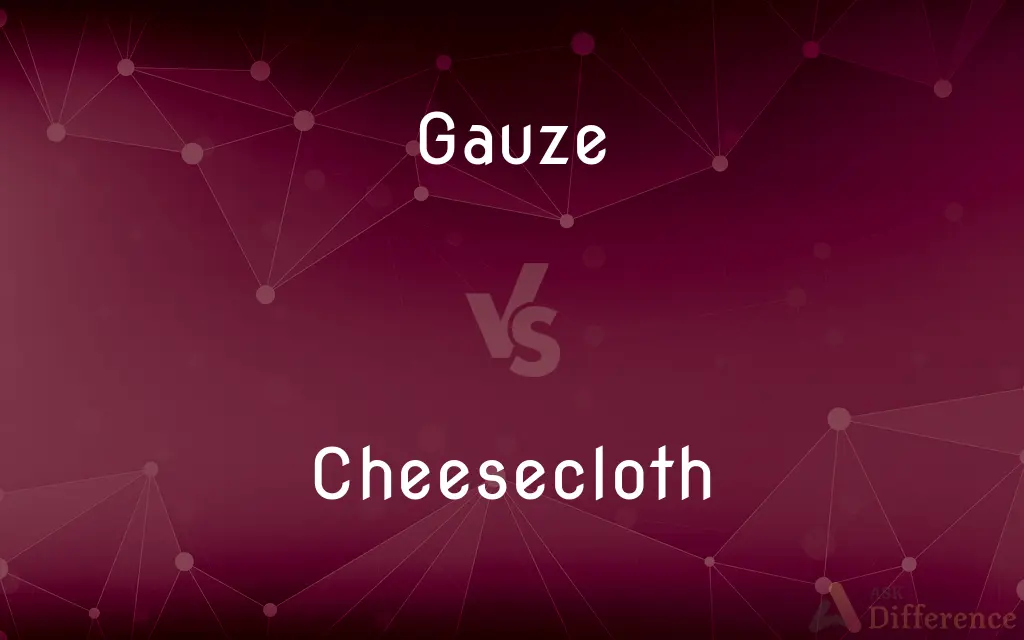Gauze vs. Cheesecloth — What's the Difference?
By Tayyaba Rehman & Maham Liaqat — Updated on April 5, 2024
Gauze is a thin, translucent fabric used for medical dressings, while cheesecloth is a loose-woven cotton cloth used in cheese making and cooking.

Difference Between Gauze and Cheesecloth
Table of Contents
ADVERTISEMENT
Key Differences
Gauze is a lightweight, woven fabric known for its airy and breathable qualities, ideal for medical bandages and wound care. Whereas cheesecloth, with its loose weave, is primarily used in culinary applications, such as straining liquids and making cheese.
While gauze is designed to be absorbent and sterile for medical applications, cheesecloth is intended for food preparation, focusing on its ability to allow air and moisture to pass through while trapping solids.
The fineness of gauze is often categorized by the number of threads per inch, contributing to its suitability for different types of medical dressings. On the other hand, cheesecloth grades are determined by the tightness of the weave, affecting its straining capabilities.
Gauze is typically made from cotton or a blend of synthetic fibers, ensuring it is soft and gentle on the skin. In contrast, cheesecloth is made from cotton, highlighting its natural, food-safe qualities.
The use of gauze extends beyond medical settings into crafts and fashion, due to its soft texture and versatility. Meanwhile, cheesecloth finds additional uses in culinary settings beyond cheese making, like in basting meats and making spice bags.
ADVERTISEMENT
Comparison Chart
Primary Use
Medical dressings and wound care.
Cheese making and culinary straining.
Material
Cotton or synthetic fibers.
Cotton.
Weave
Fine and loose, designed for absorbency.
Very loose, designed to allow air and moisture flow.
Application
Medical, crafts, fashion.
Culinary, cheese making, basting, spice bags.
Characteristics
Soft, absorbent, sterile (for medical use).
Food-safe, natural, versatile in kitchen use.
Compare with Definitions
Gauze
Absorbent Material.
Gauze pads are applied to absorb blood and exudates from wounds.
Cheesecloth
Flexible Kitchen Tool.
Cheesecloth is also utilized for making ghee and straining stocks.
Gauze
Thin, Medical Fabric.
Gauze is used to dress wounds, allowing air to aid in healing.
Cheesecloth
Culinary Applications.
Cheesecloth can be used to bundle herbs for soups and stocks.
Gauze
Versatile Fabric.
Besides medical use, gauze is used in crafts for its texture.
Cheesecloth
Graded by Weave.
Cheesecloth grades vary, with higher grades having a tighter weave.
Gauze
Various Uses.
Gauze is also utilized in fashion design for lightweight clothing.
Cheesecloth
Loose-Woven Cotton.
Cheesecloth is used for straining whey from cheese curds.
Gauze
Soft and Gentle.
Gauze is chosen for wound care because it's gentle on the skin.
Cheesecloth
Natural, Food-Safe.
Being made of cotton, cheesecloth is safe for culinary use.
Gauze
Gauze is a thin, translucent fabric with a loose open weave. In technical terms "gauze" is a weave structure in which the weft yarns are arranged in pairs and are crossed before and after each warp yarn keeping the weft firmly in place.
Cheesecloth
Cheesecloth is a loose-woven gauze-like carded cotton cloth used primarily in cheese making and cooking.
Gauze
A thin, transparent fabric with a loose open weave, used for curtains and clothing.
Cheesecloth
A coarse, loosely woven cotton gauze, originally used for wrapping cheese.
Gauze
A thin, loosely woven surgical dressing, usually made of cotton.
Cheesecloth
A loosely woven cotton gauze, originally used to wrap cheese, but now used for various culinary tasks and by farmers to shade crops and keep birds off.
Gauze
A thin plastic or metal woven mesh.
Cheesecloth
A thin, loosely-woven cotton cloth of a gauze texture, such as is used in pressing cheese curds.
Gauze
A mist or haze.
Cheesecloth
A coarse loosely woven cotton gauze; originally used to wrap cheeses
Gauze
A thin fabric with a loose, open weave.
Gauze
(medicine) A similar bleached cotton fabric used as a surgical dressing.
Gauze
A thin woven metal or plastic mesh.
Gauze
Wire gauze, used as fence.
Gauze
Mist or haze
Gauze
To apply a dressing of gauze
Gauze
(literary) To mist; to become gauze-like.
Gauze
A very thin, slight, transparent stuff, generally of silk; also, any fabric resembling silk gauze; as, wire gauze; cotton gauze.
Gauze
Having the qualities of gauze; thin; light; as, gauze merino underclothing.
Gauze
(medicine) bleached cotton cloth of plain weave used for bandages and dressings
Gauze
A net of transparent fabric with a loose open weave
Common Curiosities
How do you choose the right grade of cheesecloth?
The choice depends on the intended use; higher grades with tighter weaves are better for finer straining, while lower grades work for coarser tasks.
Can gauze be used in cooking?
While not typical, gauze can be used in cooking for straining or wrapping, but cheesecloth is preferred for its food-safe qualities.
Are gauze and cheesecloth interchangeable?
They can be in some non-medical, craft applications, but their specific qualities make them more suited to their primary uses in medical care and cooking, respectively.
What is cheesecloth used for?
Cheesecloth is used in culinary applications, such as cheese making, straining liquids, basting meats, and bundling herbs.
Can cheesecloth be reused?
Yes, cheesecloth can be washed and reused in many culinary applications, though it may lose some of its integrity over time.
Can cheesecloth be used for medical purposes?
Generally, cheesecloth is not suitable for medical purposes due to its loose weave and non-sterile nature.
Are there eco-friendly alternatives to cheesecloth?
Yes, there are reusable cheesecloths made from organic cotton or other sustainable materials.
What is gauze used for?
Gauze is primarily used for medical dressings, wound care, and in various crafts and fashion applications due to its soft and absorbent qualities.
Why is the weave important in cheesecloth and gauze?
The weave affects their functionality; a finer weave in gauze is suitable for medical applications, while a looser weave in cheesecloth is ideal for culinary straining.
How long can gauze be left on a wound?
The duration depends on the wound's condition and doctor's advice, typically changed daily or as needed to keep the wound clean.
Is all gauze sterile?
Gauze intended for medical use is sterile, but non-sterile options are available for crafts and other non-medical uses.
What materials are used to make gauze?
Gauze is usually made from cotton or a blend of synthetic fibers for softness and absorbency.
How do you clean cheesecloth?
Cheesecloth can be washed with mild detergent and water, then air-dried before reuse.
What grade of cheesecloth is best for making cheese?
A medium to high-grade cheesecloth is recommended for making cheese, as it allows whey to drain while retaining the curds.
What's the difference in absorbency between gauze and cheesecloth?
Gauze is designed to be more absorbent for medical use, whereas cheesecloth's loose weave focuses on straining and allowing air flow rather than absorbency.
Share Your Discovery

Previous Comparison
Heron vs. Stork
Next Comparison
Paragraph vs. ArticleAuthor Spotlight
Written by
Tayyaba RehmanTayyaba Rehman is a distinguished writer, currently serving as a primary contributor to askdifference.com. As a researcher in semantics and etymology, Tayyaba's passion for the complexity of languages and their distinctions has found a perfect home on the platform. Tayyaba delves into the intricacies of language, distinguishing between commonly confused words and phrases, thereby providing clarity for readers worldwide.
Co-written by
Maham Liaqat















































